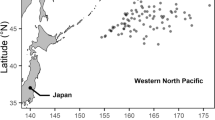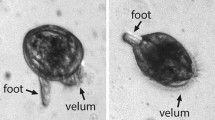Abstract
Resting schools of juvenile grunts (less than 12 cm length), composed primarily of Haemulon flavolineatum and H. plumieri, were studied from 1972 to 1976 on a series of patch reefs surrounded by seagrass beds on the northeast coast of St. Croix, U.S. Virgin Islands. Juvenile grunts form large inactive multispecies schools in reef areas by day. Repeated censuses over several years reveal that certain parts of the reef, particularly those with large formations of the corals Porites porites and Acropora palmata, are traditional schooling areas. When the fishes reach a size of about 15 cm, the H. plumieri form homotypic schools which roam the patch reefs but are no longer associated with particular formations of coral. In contrast, larger H. flavolineatum are uncommon on the patch reefs and they may move offshore to deeper water. The schools of juvenile grunts migrate some distance away (often 100 to 300 m) into seagrass-covered areas to feed on invertebrates at dusk each day. The routes which are followed into the seagrass beds are precise and persist over years. At dawn the grunts return to the reef on the same routes. Mass marking and release experiments show that juvenile grunts will move over long distances (approximately 3 km) to reach a home reef.
Similar content being viewed by others
Literature Cited
Bardach, J.E.: On the movements of certain Bermuda reef fishes. Ecology 39, 139–146 (1958)
Billings, V.C. and J.L. Munro: The biology, ecology, exploration and management of Caribbean fishes. In: Scientific Report of the ODA/UWI Fisheries Ecology Research Project, Port Royal Marine Laboratory, Jamaica, 1969–1973. Part V.e. The biology, ecology and bionomics of Caribbean reef fishes: Pomadasyidae (grunts), pp 1–128. Kingston, Jamaica: University of the West Indies 1974. Res. Rep. zool. Dep. Univ. W. Indies No. 3
Courtenay, W.R. Jr.: Western Atlantic fishes of the genus Haemulon (Pomadasyidae): systematic status and juvenile pigmentation. Bull. mar. Sci. Gulf Caribb. 11, 66–149 (1961)
Cummings, W.C., B.D. Brahy and J.Y. Spires: Sound production, schooling and feeding habits of the margate, Haemulon album Cuvier, off North Bimini, Bahamas, Bull. mar. Sci. 16, 626–639 (1966)
Ehrlich, P.R. and A.H. Ehrlich: Coevolution: heterotypic schooling in Caribbean reef fishes. Am. Nat. 107, 157–160 (1973)
Hobson, E.S.: Diurnal-nocturnal activity of some inshore fishes in the Gulf of California. Copeia 1965 (3), 291–302 (1965)
—: Predatory behavior of some shore fishes in the Gulf of California. U.S. Bur. Sport Fish Wildl. Res. Rep. 73, 1–92 (1968)
—: Diel feeding migrations in tropical reef fishes. Helgoländer wiss. Meeresunters. 24, 361–370 (1973)
Jackson, C.F.: A technique for mass marking fish by means of compressed air. Tech. Circ. New Hamps. Fish Game 17, 1–8 (1959)
McLean, R. and W.F. Herrnkind: Compact schooling during a mass movement by grunts. Copeia 1971 (2), 328–330 (1971)
Moe, M.A. Jr.: Tagging fishes in Florida offshore waters. Tech. Ser. Fla St. Bd Conserv. 49, 1–40 (1966)
Ogden, J.C.: Faunal relationships in Caribbean seagrass beds. In: Studies of the seagrass ecosystem, Ed. by R.C. Phillips and C.P. McRoy. New York: Marcel Dekker (In press)
—, R.A. Brown, and N. Salesky: Grazing by the echinoid Diadema antillarum Philippi: formation of halos around West Indian patch reefs. Science, N.Y. 182, 715–717 (1973)
Ogden, J.C. and J.C. Zieman: Ecological aspects of coral reef-seagrass bed contacts in the Caribbean. Proc. int. Symp. coral Reefs (3, Miami) (1977) (In press)
Phinney, D.E., D.M. Muller and M.L. Dahlberg: Mass marking young salmonids with fluorescent pigment. Trans. Am. Fish. Soc. 96, 157–162 (1967)
Randall, J.E.: An analysis of the fish populations of artificial and natural reefs in the Virgin Islands. Caribb. J. Sci. 3, 31–47 (1963)
—: Grazing effects on seagrass by herbivorous reef fishes in the West Indies. Ecology 46, 255–260 (1965)
Springer, V.G. and A.J. McErlean: A study of the behavior of some tagged south Florida coral reef fishes. Am. Midl. Nat. 67, 386–397 (1962)
Starck, W.A. II, and W.P. Davis: Night habits of fishes of Alligator reef, Florida. Ichthyologica 38, 313–356 (1966)
Author information
Authors and Affiliations
Additional information
Communicated by J.M. Lawrence, Tampa
Rights and permissions
About this article
Cite this article
Ogden, J.C., Ehrlich, P.R. The behavior of heterotypic resting schools of juvenile grunts (Pomadasyidae). Mar. Biol. 42, 273–280 (1977). https://doi.org/10.1007/BF00397751
Accepted:
Issue Date:
DOI: https://doi.org/10.1007/BF00397751




